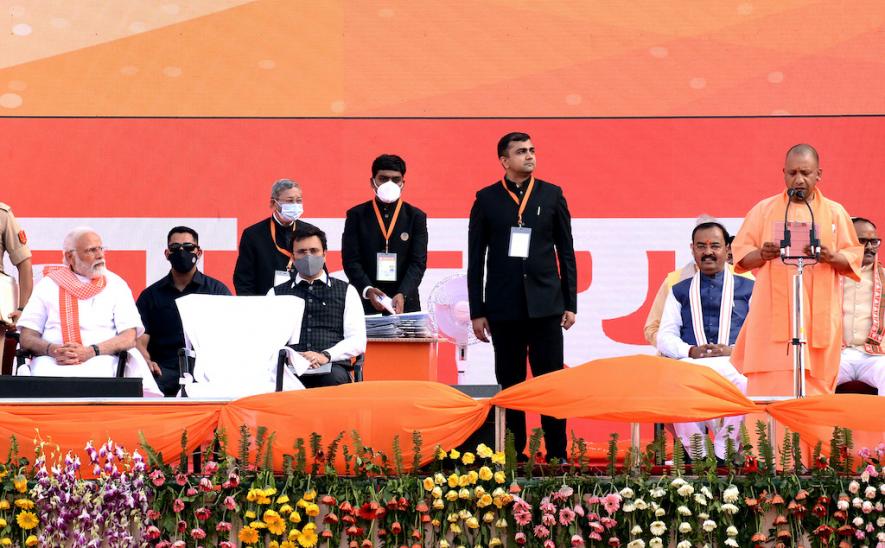UP: Heavy Dominance of Upper-Castes Ministers in Yogi 2.0, Under-representation of Women and Muslims

After indications that the Narendra Modi vs Yogi Adityanath combat within the Bharatiya Janata Party (BJP) was settled in the former's favour at the swearing-in ceremony of Yogi 2.0, where the prime minister was the clear Master of Ceremony, it appears that the chief minister is not completely acquiescing to the Centre's dominance.
As allocations of portfolios within his council of ministers make it evident, Adityanath will continue losing no opportunity to establish his autonomy despite his reduced elbow room. This makes tracking this saga, which is effectively the first potential challenge to Modi from within the Sangh Parivar, a tantalising prospect.
Before examining this narrative within the BJP, which is discussed with extreme discretion, an essential set of facts. Uttar Pradesh has a new deputy chief minister in Brajesh Mishra, who was a cabinet minister in the Yogi 1.0 government.
Originally from the Bahujan Samaj Party, he was inducted into the ministry in March 2017, barely weeks after joining the BJP in Amit Shah's presence. Pathak was allocated the important Law and Justice ministry besides charge of departments of Additional Energy Resources and Political Pension.
Minor alterations were made to his portfolio when the chief minister reshuffled his pack for the first time in August 2019. However, relations between the two went south after Pathak flagged his concern over the management of the second wave of the COVID-19 pandemic last year and the state of health infrastructure in the state.
His letter to the Health Secretary, details of which were published in the media, was not viewed kindly by Adityanath. Pathak termed the situation in the state capital of Lucknow as 'worrisome' and wrote that "there are no beds in the hospitals....the patients are neither getting ambulances on time nor are they receiving treatment."
Four months later, Pathak tested positive for COVID-19 and in a sign that he had not been wrong in flagging the state government's ineptitude, several ministers and legislators died.
Pathak's letter was followed by other BJP leaders criticising the UP government. It included then union minister Santosh Gangwar who was subsequently dropped from the council of ministers in July 2021 by Modi. But Pathak was not axed for his public letter on the poor performance of the Adityanath government, possibly because he had the central leadership's blessings.
After being saddled with Pathak as deputy chief minister, Adityanath did what was within his power – allocate relatively minor portfolios to him: Medical Education, Medical Health, Family Welfare, Mother and Child Welfare. Significantly, all these ministries are those against which Pathak complained last year. The message is clear – if you have a 'problem' with these departments, 'manage them'.
But Adityanath has not opted to, or cannot be, all-out 'vengeful' in portfolio allocation. For instance, Keshav Prasad Maurya, not a loyalist of the chief minister, lost out on the crucial Public Works Department to former Congress leader Jitin Prasad, in whom greater trust has been reposed.
But, the deputy chief minister, who surprisingly lost his election, has been 'compensated' by being given charge of the powerful and resource-rich rural development ministry and six other departments, including rural engineering, entertainment tax, food processing, public enterprises and national integration.
In a tight balancing act between agreeing to moderate his autonomy that he displayed with flair and publicity in his first tenure, Adityanath not only included in the cabinet the Modi-confidante, Arvind Kumar Sharma – the former career bureaucrat – but also allocated the crucial responsibilities of Urban Development, Overall Urban Development, Urban Employment and Poverty Alleviation, Energy, Additional Sources of Energy to him.
This decision also indicates that on matters related to these crucial departments' functioning, there will be 'direct coordination between the minister and PMO.
It requires recalling that Sharma sought premature retirement after ties between Adityanath and the PMO began becoming tense at the end of 2020 due to the chief minister's insistence to plough the lonely furrow and not govern in 'synchronisation' with the PMO. When Sharma was made 'elected' to the Legislative Council, it was widely believed that he had been sent to UP for a political role.
This was disallowed by Adityanath, who also kept the spotlight on himself through 2021 and during the early period of the electoral campaign. The Modi-Shah duopoly did not upset the apple cart and tried 'straightening out' Adityanath because they were not sure of people not voting based on their material condition, inept COVID management and the government's incapacity to get the economy running.
But from halfway through the campaign, when the Modi-Shah duo took a more 'visible lead' and after the verdict, to put it figuratively, the 'empire' struck back. Modi claimed the victory as his own, embarked on victory rallies morphing into the party's electoral campaign launch in Gujarat, and declared Adityanath's mandate was from 2022-2027, suggesting that in his mind, the Yogi's role was principally limited to the state.
In this game of one-upmanship in which Adityanath tries to be 'different' from other 'pliant' BJP chief ministers, while the central leadership keeps reminding him of the party's template of the power equation between the central and state leader, certain typical practices continue.
To begin with, despite the brouhaha over BJP getting its social engineering act together and making inroads in non-dominant sub-castes among OBCs and Dalits, out of 52 members of the entire crop of ministers, there are 21 upper-caste ministers, of whom 13 are either Brahmins or Rajputs.
Not just Muslims but women too remain grossly under-represented – just one cabinet minister and three junior ones. Even in the choice of portfolios, stereotypes prevail: women have been given charge of 'only' women's welfare and child nutrition or other 'soft' ministries while the only Muslim minister will look after only matters pertaining to the community.
Likewise, Sanjay Nishad was limited to the fisheries department, and the former IPS officer, Asim Arun, was given charge of the ministries/departments of Social Welfare, Scheduled Caste and Tribal Welfare which completely or substantially deal with matters related to the scheduled castes, a community that the cop turned politician was born into.
Despite the enhanced support for BJP from the Dalits, especially Jatavs, the number of Dalit ministers in Yogi 2.0 remains at eight – which indicates that the BJP's social engineering is not at linking representation to demographic presence.
Much of the road to 2024 shall be shaped by the performance of the UP government, the ease in the relationship between the Modi-Shah duopoly and Adityanath, especially in the contexts of government functioning, as well as his complete integration into the party machinery (which entails trimming the Hindu Yuva Manch completely) and also the ability of the opposition to make gains by use of opportunities provided by the BJP.
A little-spoken issue that requires a mention is BJP's failure to provide adequate representations to all districts uniformly – almost half of the 75 districts have no ministers, including four of the five administrative units where the party did not win a single seat. In contrast, several districts have multiple ministers. Unsurprisingly, Varanasi has three.
(The writer is an NCR-based author and journalist. His latest book is The Demolition and the Verdict: Ayodhya and the Project to Reconfigure India. His other books include The RSS: Icons of the Indian Right and Narendra Modi: The Man, The Times. He tweets at @NilanjanUdwin)
Get the latest reports & analysis with people's perspective on Protests, movements & deep analytical videos, discussions of the current affairs in your Telegram app. Subscribe to NewsClick's Telegram channel & get Real-Time updates on stories, as they get published on our website.























